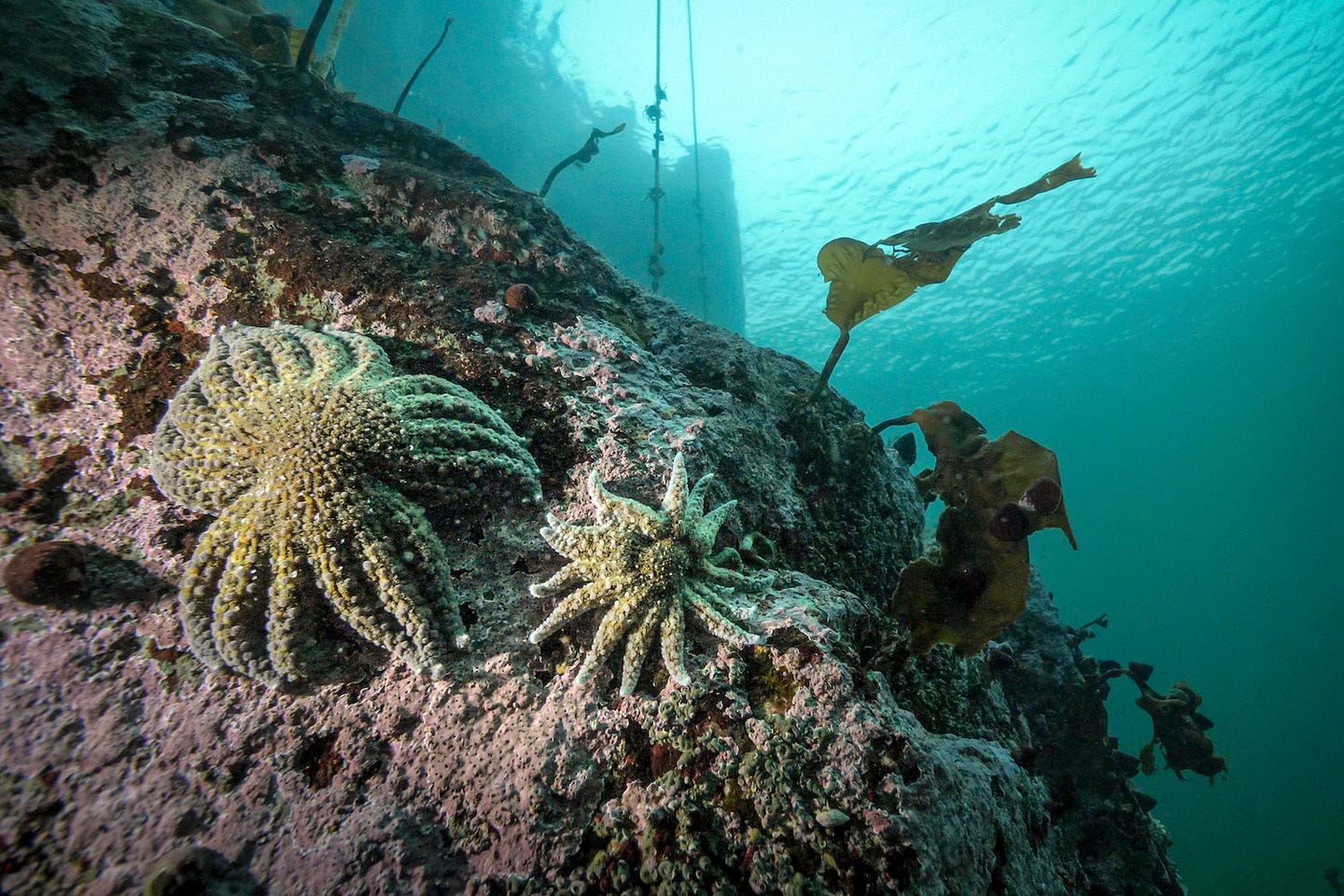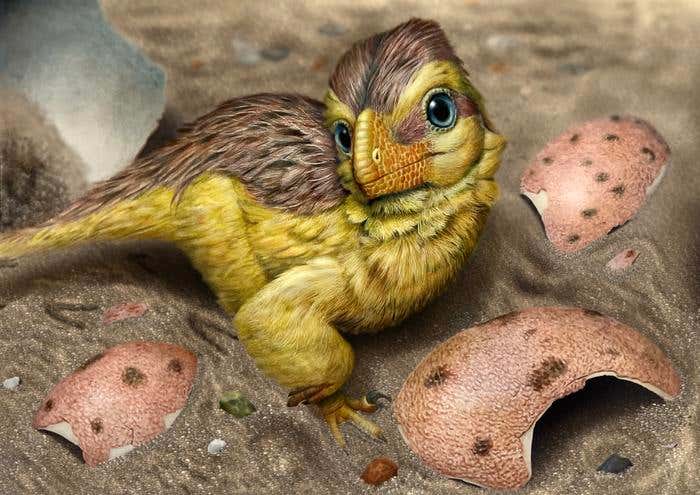What killed 5 million sea stars off the coast of North America?
This epidemic, known as sea star wasting disease, swept from Mexico to Alaska, hitting over 20 species and collapsing one of the ocean’s most important predator populations.

Pycnopodia in Burke Channel. (CREDIT: Grant Callegari / Hakai Institute)
Starting in 2013, sea stars along the Pacific Coast began dying by the billions. Their once full and vibrant arms shriveled, twisted, and fell off. Within a few days, what was a living, colorful creature melted into the ocean floor.
This epidemic, known as sea star wasting disease, swept from Mexico to Alaska, hitting over 20 species and collapsing one of the ocean’s most important predator populations. The most devastated was the sunflower sea star, a giant with up to 24 arms and a hunger for sea urchins. Over 90% vanished within just five years.
Now, more than a decade later, scientists finally know what caused it. The culprit is a strain of bacteria called Vibrio pectenicida, the same group known to affect shellfish, coral, and even humans.
A Hidden Killer in the Ocean
Researchers had suspected a virus for years, especially after finding densovirus in many affected sea stars. But later work revealed that healthy stars also carried this virus, making it unlikely to be the cause. The real clue was hiding in a fluid most early studies overlooked — the coelomic fluid, the watery substance that fills a sea star’s body and surrounds its organs.
Alyssa Gehman, a marine disease ecologist at the Hakai Institute and the University of British Columbia, led the team that cracked the case. They ran exposure experiments with sunflower sea stars using tissue extracts, fluids, and water from infected stars. The results were striking: healthy stars exposed to this material quickly became sick, while control stars stayed healthy.
When researchers sequenced the DNA in the coelomic fluid of the sick stars, nearly all the microbial signals pointed to Vibrio pectenicida. “We all had chills,” Gehman said. “We thought, ‘That’s it. We have it. That’s what causes wasting.’”
Related Stories
- Ancient fossil reveals spiders and their relatives originated in the ocean, not on land
- Scientists discover what wiped out global ocean life 200 million years ago
- 540 million years of ocean life measured in landmark global study
Confirming the Cause of Sea Star Wasting Disease
To be sure, the team followed Koch’s postulates, a standard method in disease research. They isolated V. pectenicida from the sick stars, grew it in pure cultures, and then injected it into healthy sunflower sea stars. The same gruesome symptoms followed: lesions, contorted arms, and tissue decay. The bacteria had passed the final test — proving it was the main cause of sea star wasting disease.
Melanie Prentice, the study’s lead author and an evolutionary ecologist at the Hakai Institute and UBC, said solving the mystery came from years of persistence and the right research conditions. They had access to high-quality lab facilities at the U.S. Geological Survey and healthy test animals raised in captivity.
“I observed and collected health data on nearly every single sea star twice a day for four summers,” said co-author Grace Crandall, a University of Washington doctoral student. “To participate in research with such major conservation impact has been a dream come true.”
Drew Harvell, a longtime researcher from the University of Washington who co-authored the study, reflected on the long path to discovery. “This is the discovery of the decade for me,” she said. “What’s crazy is that the answer was sitting right there in front of us.”
Vibrio pectenicida: A Sneaky and Destructive Pathogen
The focus keyphrase, Vibrio pectenicida, isn’t just any bacteria. It belongs to a genus that includes Vibrio cholerae, the cause of cholera in humans. In marine ecosystems, other species of Vibrio have devastated coral reefs and shellfish farms.
This particular strain, V. pectenicida FHCF-3, had escaped detection because it didn’t show up on standard histology tests. “It’s a sneaky critter,” Harvell said. That made the road to discovery unusually long and full of detours.
Blake Ushijima, a microbiologist at the University of North Carolina, praised the team’s detective work. “It’s incredibly difficult to trace the source of environmental diseases, especially underwater,” he said. “This was really smart and significant science.”
Consequences That Ripple Through the Ecosystem
Sunflower sea stars may look harmless, but they play a massive role in keeping kelp forests healthy. These stars are top predators that feed on sea urchins — creatures that can destroy kelp forests if left unchecked.
After the stars disappeared, sea urchin populations exploded. Within 10 years, they chewed through about 95% of Northern California’s kelp forests. That loss had a domino effect on the entire coastal ecosystem. Fish, seals, and sea otters all lost food and habitat.
“Losing a sea star goes far beyond the loss of that single species,” Prentice said. “It shifts the entire ecosystem.”
Kelp forests, often called the “rainforests of the ocean,” are some of the most productive marine habitats on Earth. Their decline puts biodiversity, fisheries, and even carbon storage at risk.
Using the Discovery to Save Sea Stars
Now that researchers know Vibrio pectenicida is behind the disease, they can begin targeted recovery work. Scientists may test wild sea star populations for resistance, breed healthy individuals in labs, and reintroduce them to areas where the population collapsed.
There’s also interest in studying how climate affects the disease. Warmer waters may help Vibrio species thrive, possibly making sea star wasting disease more intense in a warming world.
“We can now explore whether some populations have natural immunity,” Gehman said. “Maybe even test whether probiotics could help.”
Having this confirmed cause also allows scientists to run culture-based lab experiments and screen for the pathogen in the field. This opens doors to future interventions and better long-term planning.
“This is a major step forward,” said Rebecca Vega Thurber, a marine microbiologist at UC Santa Barbara. “It solves a long-standing question about a very serious disease in the ocean.”
A Glimmer of Hope for a Fallen Icon
With up to 24 arms and a size comparable to a bicycle tire, the sunflower sea star is one of the largest and most striking marine invertebrates. Their loss was not just a biological tragedy but also a deeply emotional one for scientists who worked closely with them.
“It’s just heartbreaking to watch them die,” Harvell said. “Sunflower sea stars are enchanting creatures and they’re quite interactive. At feeding time, they’ll come toward you. If you throw clams, they catch them.”
The discovery of Vibrio pectenicida as the cause offers a much-needed sense of progress — and the promise of healing for ecosystems that have been out of balance for over a decade.
Research findings are available online in the journal Nature Ecology & Evolution.
Note: The article above provided above by The Brighter Side of News.
Like these kind of feel good stories? Get The Brighter Side of News' newsletter.



